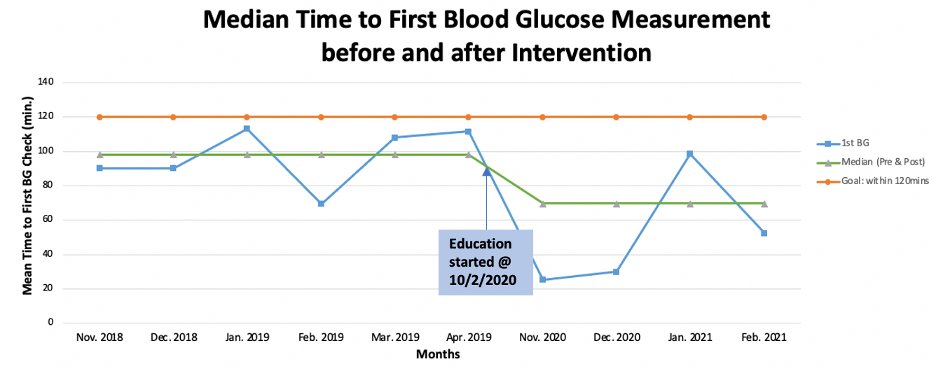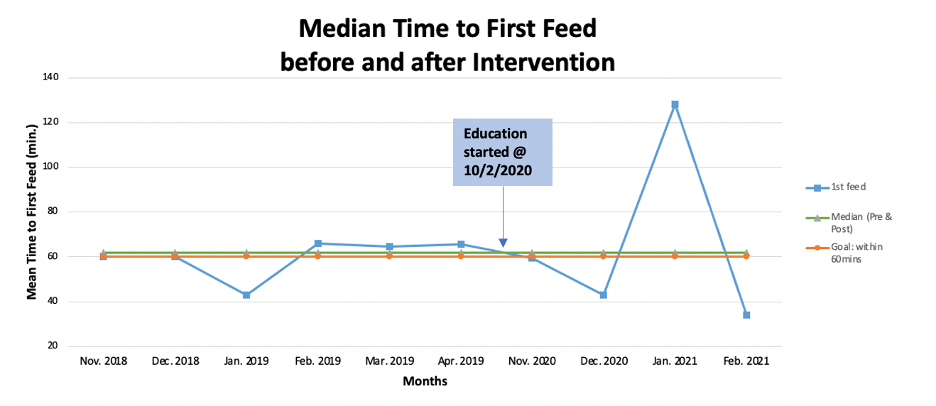Back
Neonatal Quality Improvement
Category: Abstract Submission
Neonatal Quality Improvement V
392 - Incidence of Hypoglycemia in At-risk Newborns and Improving Adherence to Neonatal Hypoglycemia Management Guideline
Monday, April 25, 2022
3:30 PM – 6:00 PM US MT
Poster Number: 392
Publication Number: 392.435
Publication Number: 392.435
Ying Ge Wang, Cooper Medical School of Rowan University, quincy, MA, United States; Melissa Micallef, Cooper Medical School of Rowan University, Springfield, PA, United States; Vineet Bhandari, The Children's Regional Hospital at Cooper, Camden, NJ, United States; Alla Kushnir, The Children's Regional Hospital at Cooper, Camden, NJ, United States

Ying Ge Wang
MS4
Cooper Medical School of Rowan University
quincy, Massachusetts, United States
Presenting Author(s)
Background: Certain neonates are at an increased risk of hypoglycemia in the newborn period. The American Academy of Pediatrics (AAP) recommends strictly adhering to a screening and treatment guideline for infants with risk factors for hypoglycemia in order to prevent severe neurologic sequelae and protect future neurological function.
Objective: To assess risk factors and incidence of hypoglycemia in at-risk newborn infants in an inner city tertiary care hospital, and to evaluate and improve adherence to the AAP neonatal hypoglycemia guideline for newborns in the first 48 hours of life.
Design/Methods: All neonates born 11/2018 - 5/2019 were evaluated for hypoglycemia risk factors. The level of compliance with the AAP recommendations for management of neonatal hypoglycemia in the first 48 hours was evaluated by documenting risk factors, time of first feed and first blood glucose (BG) check, first BG check after first feed, first BG check within 120 minutes of life, and BG monitoring for the first 48 hours. Both pre-intervention (11/2018 - 5/2019) and post-intervention data (10/2020 - 02/2021) were collected via EPIC chart review. Interventions were implemented using PDSA (plan/do/study/act) system and included nursing education, educational poster display and creation of handouts to be given to families.
Results: 149 (24.0%) of the 621 patients born in 11/2018-5/2019 had at least one risk factor for hypoglycemia and 19 (14.1%) of 135 patients born in 10/2020- 02/2021 (post first PDSA cycle) had at least one risk factor for hypoglycemia. Among neonates with risk factors, median time to first feed was 62 minutes of life, which did not improve after the initial intervention. Median time to first BG check was 98 minutes of life in those with risk factors, which improved to 70 minutes after the intervention. Only 49.7% had 1st feed within 60 minutes and 31.7% had 1st BG check after 1st feed and within 120 minutes after delivery. These have shown slightly improvement after the intervention. BG was monitored for 24 hours in 93% of at-risk neonates, which improved to 100% after the interventions.Conclusion(s): Infants with low birth weight (birth weight < 2500 grams) have the highest risk of developing hypoglycemia compared to that of other risk factors. Our compliance to AAP neonatal hypoglycemia guideline before intervention had areas of improvement, specifically in time to initiate feeds and first BG check. After the intervention, we showed significant improvement in time to first BG check and achieved 100% BG monitoring at 24 hours of life.
Median Time to First Blood Glucose Measurement before and after Interventions Median time of first blood glucose measurement before and after interventions. Washout period of 2 weeks after the introduction of the education.
Median time of first blood glucose measurement before and after interventions. Washout period of 2 weeks after the introduction of the education.
Median Time to First Feed before and after Interventions Median time of first feed before and after interventions. Washout period of 2 weeks after the introduction of the education.
Median time of first feed before and after interventions. Washout period of 2 weeks after the introduction of the education.
Objective: To assess risk factors and incidence of hypoglycemia in at-risk newborn infants in an inner city tertiary care hospital, and to evaluate and improve adherence to the AAP neonatal hypoglycemia guideline for newborns in the first 48 hours of life.
Design/Methods: All neonates born 11/2018 - 5/2019 were evaluated for hypoglycemia risk factors. The level of compliance with the AAP recommendations for management of neonatal hypoglycemia in the first 48 hours was evaluated by documenting risk factors, time of first feed and first blood glucose (BG) check, first BG check after first feed, first BG check within 120 minutes of life, and BG monitoring for the first 48 hours. Both pre-intervention (11/2018 - 5/2019) and post-intervention data (10/2020 - 02/2021) were collected via EPIC chart review. Interventions were implemented using PDSA (plan/do/study/act) system and included nursing education, educational poster display and creation of handouts to be given to families.
Results: 149 (24.0%) of the 621 patients born in 11/2018-5/2019 had at least one risk factor for hypoglycemia and 19 (14.1%) of 135 patients born in 10/2020- 02/2021 (post first PDSA cycle) had at least one risk factor for hypoglycemia. Among neonates with risk factors, median time to first feed was 62 minutes of life, which did not improve after the initial intervention. Median time to first BG check was 98 minutes of life in those with risk factors, which improved to 70 minutes after the intervention. Only 49.7% had 1st feed within 60 minutes and 31.7% had 1st BG check after 1st feed and within 120 minutes after delivery. These have shown slightly improvement after the intervention. BG was monitored for 24 hours in 93% of at-risk neonates, which improved to 100% after the interventions.Conclusion(s): Infants with low birth weight (birth weight < 2500 grams) have the highest risk of developing hypoglycemia compared to that of other risk factors. Our compliance to AAP neonatal hypoglycemia guideline before intervention had areas of improvement, specifically in time to initiate feeds and first BG check. After the intervention, we showed significant improvement in time to first BG check and achieved 100% BG monitoring at 24 hours of life.
Median Time to First Blood Glucose Measurement before and after Interventions
 Median time of first blood glucose measurement before and after interventions. Washout period of 2 weeks after the introduction of the education.
Median time of first blood glucose measurement before and after interventions. Washout period of 2 weeks after the introduction of the education.Median Time to First Feed before and after Interventions
 Median time of first feed before and after interventions. Washout period of 2 weeks after the introduction of the education.
Median time of first feed before and after interventions. Washout period of 2 weeks after the introduction of the education.